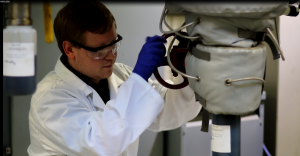
Joe Polin, a graduate student in mechanical engineering at Iowa State, is on a research team investigating a new technology for converting biomass into fuels and chemicals.
By Robert Mills, Bioeconomy Institute, Iowa State University (bei@iastate.edu)
A team of researchers from Iowa State University’s Bioeconomy Institute are investigating a new technology for converting biomass into biofuels and chemicals. With a $371,000, one-year grant from the U.S. Dept. of Energy’s Advanced Research Projects Agency-E (ARPA-E), the team will develop and demonstrate catalytic autothermal pyrolysis (CAP) in laboratory- and pilot-scale reactors.
With traditional pyrolysis, biomass is heated in the absence of oxygen to produce bio-oil, which can then be turned into fuels and chemicals. But with CAP, a small amount of air is purposefully admitted into the system in the presence of a zeolite catalyst. This modification allows the process to generate its own heat for pyrolysis and catalysis rather than relying on outside sources.
The Sweet Spot for Autothermal Pyrolysis
“It has been difficult to find the right conditions for autothermal pyrolysis to work,” said Mark Wright, an Iowa State assistant professor of mechanical engineering and lead investigator on the project. “Too much oxygen, and the biomass combusts. Too little, and the system requires an external heat source, defeating the purpose. We’ve been able to find the ‘sweet spot’ that provides the optimal conditions, allowing us to remove the external heat source and maintain the quality of the product.”
The CAP system provides “process intensification,” which means it can produce up to five times the amount of biofuel as a traditional pyrolysis system of the same size. Moreover, by eliminating cumbersome indirect heating methods such as heat exchangers, circulating solids, and separate combustion units, a CAP system is much simpler. As a result, the design of a CAP system lends itself to modularization, which can reduce the cost of manufacturing and installation.
The goal for this APRA-E project is to demonstrate the production of transportation fuel intermediates and fuel enhancers using CAP technology. The researchers will develop models of CAP reactors and determine their commercialization potential and environmental impacts. If the technology can be scaled and is economically viable, it could be used for distributed processing of cellulosic biomass, such as corn stover and switchgrass, into drop-in biofuels.
The institute’s initial work on modular pyrolysis was the result of a grant from the Iowa Energy Center. In addition to Wright, the team includes Robert C. Brown, BEI director and Anson Marston Distinguished Professor in Engineering; Ryan Smith, deputy director of BEI; and Joe Polin, a graduate student in mechanical engineering.
The U.S. Dept. of Energy’s Advanced Research Projects Agency-Energy (ARPA-E) advances high-potential, high-impact energy technologies that are too early for private-sector investment. ARPA-E awardees are unique because they are developing entirely new ways to generate, store, and use energy.
The Bioeconomy Institute at Iowa State University is a multidisciplinary research organization that advances the use of biorenewable resources for the production of fuels, energy, chemicals, and materials.
Read at Bioeconomy Institute

Recent Comments